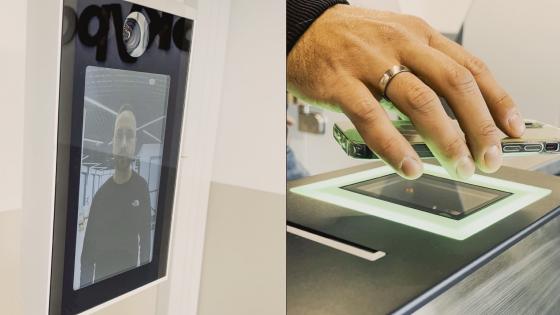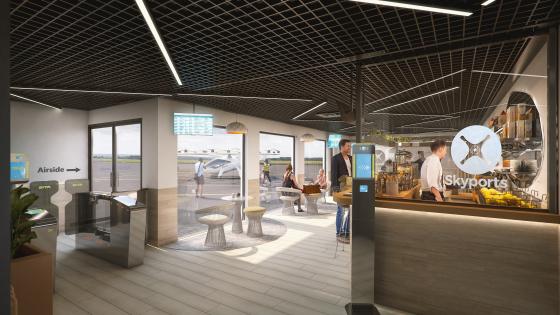Sergio Colella, president of SITA Europe, tells Tara Craig why the air travel IT specialist chose to venture into the world of vertiports
Why get involved in vertiports? What does the sector offer SITA?
For more than 70 years we’ve served the air transport industry and we’ve developed a profound understanding of the complexities of the sector, while placing ourselves at the leading edge of technological innovation for aviation processes. This experience positions us perfectly to apply our expertise as a partner to the emerging advanced air mobility (AAM) sector.
It is estimated that 70% of future AAM routes will fly from airports to city centres, so it makes sense for the industry that we help to connect this mode of transport with commercial aviation and ensure a seamless passenger experience across the two. We relish the opportunity to leverage our existing portfolio to reinvent how people will travel in the future.
By collaborating with all stakeholders – from regulators, manufacturers and vertiport operators, to airlines, airports and air traffic management – SITA will play an integral role in shaping the future of AAM, developing new operating standards and a digital-first passenger experience.
What stage have your vertiport projects reached?
We have partnered with UrbanV and Skyports to build a pioneering digital-first passenger experience at their testbed vertiports at Rome Fiumicino Airport and Cergy-Pontoise near Paris, respectively. We are working towards deploying this for their first flights in 2024. We are extremely proud to be involved in getting off the ground the very first operational vertiports worldwide.
Beyond this – and based on this work – we are looking to support airports around the globe in expanding their vertiport operations.

Sergio Colella has been president of SITA Europe since July 2017
What knowledge and experience can SITA offer?
We will contribute to the development of the AAM industry in two major ways. Air travel is highly regulated. As one of the longest-standing industry partners, we have operated in this space for many years, working closely with our airline and airport customers. We can use this expertise to help AAM operators understand the landscape and adapt their operating standards accordingly. We can also apply this knowledge to streamline processes in AAM.
We have also consistently placed ourselves at the leading edge of technological innovation for our aviation partners, and we will similarly tailor solutions to the AAM space. Across our portfolio, spanning passenger processing with biometrics and self-service, scheduling, baggage management, communications and data exchange, and beyond, we’re creating a cutting-edge IT toolkit that integrates vertiports with the aviation ecosystem while optimising the passenger experience.
Which of your digital solutions will be used in vertiports?
Our key focus is building a digital-first, self-service passenger experience that enables travellers to breeze through vertiports. The first step is pre-arrival at the vertiport: the passenger enrols on the eVTOL operator’s customer app as they would on an airline app. For this step, we use our SITA Smart Path Mobile solution to enable passengers to register their biometric profile. Once this is done, upon arrival at the vertiport the passenger undergoes a pre-security identity check, where our Smart Path Hub solution, supported by our e-gates, authenticates the passenger’s identity and validity of their boarding pass with the vertiport operator.

SITA aims to build a digital-first, self-service passenger experience for vertiport users
How will you adapt airport solutions for vertiports?
Travel is becoming increasingly intermodal. We estimate that, by 2030, seamless intermodal travel will emerge, with single processing and verification points that enable a fluid end-to-end journey across land, sea and air. As part of our Digital Travel vision, we want to see each mode of transport neatly integrated with the next, so we are prioritising adapting our portfolio to be interoperable across transport modes, including AAM.
On the passenger processing side, this means ensuring that a passenger’s biometric profile, say, when checking in on the Volocopter customer app, is compatible with Star Alliance’s biometric token systems. Airports can then leverage their existing infrastructure to integrate smoothly with the vertiport. The AAM industry’s emerging nature also makes it a valuable space for experimentation with new solutions like Digital Identity.
From an airside perspective, we are incorporating our SITA Airport Management solution, adding a module that enables vertiports to manage ground resources and scheduling. Other possibilities include configuring an airport’s interface to add an AAM area, supporting it in consolidating oversight of airport and AAM operations.
The AAM industry’s emerging nature makes it a valuable space for experimentation with new solutions
What role will data play?
To support one airline flight there can be up to 20 stakeholders who need to work together. The number and range of stakeholders only increases for intermodal journeys. As part of the intermodal future of travel mentioned earlier, we will start to move from the community of 10+ players required to take care of a single flight offer from A to B, towards an ecosystem of 100+ active contributors that will deliver a seamless door-to-door travel experience.
Crucial to making this work is securely sharing critical data, in real time, across these stakeholders to enable the seamless journey that passengers expect. We want to ensure vertiports are built to connect with commercial aviation based on a common language, whether it be powering rapid transmission of flight delay updates from an airport to a vertiport’s scheduling systems, or ensuring exchange of baggage information from flight to eVTOL journey so that baggage can be delivered directly to passengers’ end destinations. Accurate, secure and timely data exchange will support the travel experience of the future.
What do you feel SITA has gained from its initial vertiport experiences?
The partners we are working with in this new segment – be it vertiports or eVTOL operators – are not necessarily from an aviation background. Coming from retail, banking and big tech companies with different technological cultures, they are bringing a completely fresh view of the aviation sector. This is pushing us to embrace different ways of thinking and accelerate our transformation using highly agile cloud-based and event-driven architecture.

SITA is working with Skyports at its Cergy-Pontoise testbed vertiport outside Paris
Which vertiport players have inspired you?
We have long been inspired by the pioneering spirit of Volocopter, which launched some of the world’s first eVTOL services. We are proud to be partnering with the company as its preferred digital and IT systems provider and joining its Series E funding round. We are aligned in our vision of an integrated AAM ecosystem enabling an end-to-end air transport experience for passengers.
We are also inspired by our two existing vertiport operator partners, UrbanV and Skyports supported by Aeroporti di Roma and Aéroports de Paris, who are also working towards a future of vertiports that deploy common-use platforms to be interoperable by multiple eVTOL operators and integrated within local aviation ecosystems.
What next for SITA and the vertiports sector?
We intend to continue playing a key role in the development of the AAM sector worldwide, supporting vertiports and eVTOL operators in adopting common platforms to simplify operations. By deploying our AAM toolkit and solutions, vertiports will be able to connect rapidly with eVTOL operators, giving the latter greater opportunities to scale up as soon as they are commercially certified. We are prioritising France, Italy, Saudi Arabia, Japan and the United States. In Latin America, we are focusing on Brazil, establishing strong vertiport partners so that eVTOL operators in the region can have one common integration platform.
